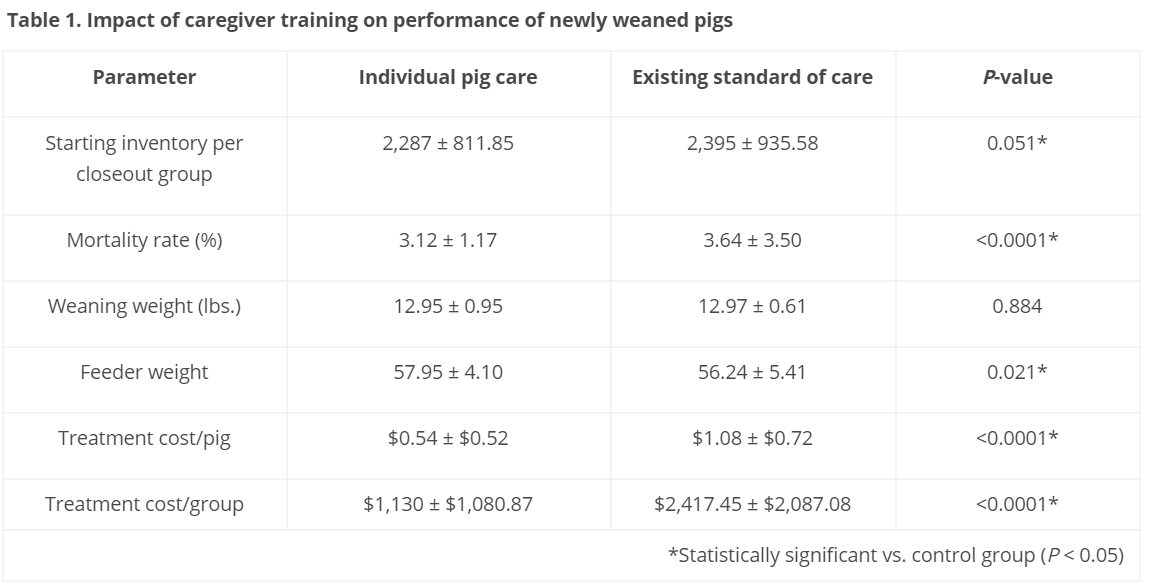



Training Caregivers to Spot Sick Pigs Early Leads to Higher Performance, Lower Mortality
Pig health is critical for maintaining animal welfare and ensuring a steady supply of safe and affordable pork. “Sustainable Health” is a series of articles about common health issues in today’s swine herds and options available for managing them sustainably.When swine veterinarian Lucina Galina showed up to lead a caregiver training program at a farm in Minnesota, she was greeted by a welcome sight. The pigs looked plump and healthy, their barns were clean and well ventilated, and the 2,500-head operation was clearly managed with care.
“At first glance, I was wondering how we were going to lead the training — there didn’t appear to be much room for improvement,” Galina recalls. “As a veterinarian, that’s something I’m always happy to see.”
But as Galina has observed often in her career, initial appearances can be deceiving. Once she entered the pens to do a pre-training assessment, she quickly noticed something was wrong.
“When we took a closer look and started moving around with the pigs, we noticed several were lame,” she reports. “This alerted us to a late-finishing outbreak of Mycoplasma hyosynoviae in the herd that required urgent intervention. Had we not entered the pens, we may not have caught it, and the situation could have quickly gotten much worse.”
A closer look
“Taking a closer look” is exactly what Galina — senior manager of pork technical services at Zoetis — emphasizes in the Zoetis-sponsored caregiver training programs, which promote early detection and treatment of disease through the concept of “individual pig care.” By learning to recognize early signs of illness in individual pigs, caregivers and veterinarians can respond more quickly, reducing the progression and spread of disease while limiting related costs.
“Subclinical disease in post-weaning pigs can be just as damaging to herd profitability as acute outbreaks. Pigs that appear healthy on superficial inspection may have early-onset or subacute disease that can result in decreased feed efficiency, slow growth, failure to thrive, and increased morbidities and mortalities,” she explains.
“To a great extent, the infectious, nutritional and environmental challenges affecting post-weaning pigs can be offset by careful husbandry, with an emphasis on daily examination of every pig in the nursery and treatment at early stage of disease. Individual pig care is also critical in the finishing stage, when pigs are highly valuable after being raised and fed for 6 months.”
Proven benefits
Caregiver training has proven benefits, Galina reports. In 2013, Journal of Swine Health and Production published two large studies designed to measure the impact of the Zoetis trainings on mortality, productivity and treatment costs in nursery pigs, compared to standard of care without training.
In the groups that received training, coaches taught caregivers to examine each pig daily, employing a disease-severity system to differentiate suboptimal pigs. The system classified these pigs at early, moderate and advanced stages of the disease, or requiring humane euthanasia (Figure 1).

“The classification system trained caregivers to determine which pigs needed intervention and when to intervene,” Galina explains. “This allowed prompt treatment, particularly when the caregivers were able to execute pre-existing treatment protocols established by the herd veterinarian.”
Results indicate that caregiver training made a meaningful difference. Compared to pigs raised under the existing standard of care, pigs in the trained-caregiver group had significantly lower mortalities and treatment costs, as well as higher productivity. Overall, the studies revealed that caregiver training led to one additional high-value nursery pig for every 43 pigs raised (Table 1).
The bigger picture
Caring for pigs individually starts with looking at the bigger picture, Galina says. Before examining each pig individually, she recommends a systematic assessment of environmental and nutritional factors, followed by an evaluation of general herd health and behavior.
Disease monitoring is just one aspect of good husbandry, she stresses. Dietary changes, environmental stressors and competition with litter and pen mates contribute to higher risk of mortality and poor performance in post-weaning pigs, so these factors must also be monitored and managed carefully.
Long-term sustainability
According to Galina, good husbandry not only keeps pigs healthier, productivity higher and costs and mortalities lower, it also promotes higher welfare standards and judicious antimicrobial use, which are increasingly important to today’s consumers.
“There will still be times when mass medication is needed, but if you identify disease early, you will more likely be able to limit treatment to individual pigs,” she says. “In some cases, treatment may not even be necessary — sometimes, animals that are falling behind just need space to recover.”
She adds, “When caregivers know how to detect disease early, they can work more productively, communicate more effectively and take action more quickly when needed. That leads to better health and welfare, improved performance and efficiency, and greater employee productivity and engagement — all of which are critical to a pig farm’s long-term sustainability.”
Taken from Voice of Sustainable Pork








